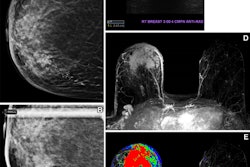
Racial disparities continue to persist when it comes to low-dose CT (LDCT) lung cancer screening, according to a presentation delivered September 8 at the International Society of Computed Tomography (ISCT) meeting in San Diego.
Presenter Arun Krishnaraj, MD, of the University of Virginia in Charlottesville described how he and colleagues investigated lung cancer screening uptake and discovered racial and ethnic disparities among the pool of eligible individuals -- most noticeably among Hispanics.
"The broader goal [of our research was] to analyze social determinants of health and implement outreach strategies to decrease the disparity gap in our community," he said.
Despite a 2021 broadening of the pool of individuals eligible for annual lung cancer screening, uptake of the exam is about 6% in the U.S., and about 8% in Virginia -- a state that has high smoking rates, Krishnaraj said.
The University of Virginia implemented a lung cancer screening program in 2014, and since then, just 2,173 patients from areas served by the university have been screened, Krishnaraj said. Mostly these individuals are referred by primary care providers, although self-referral is an option, he noted.
To better understand why lung cancer screening uptake is low, Krishnaraj and colleagues performed a demographic analysis of the screened population (gender, race, ethnicity, age at first screening), explored social determinants of health (primary language, zip code, county, and marital status), and developed outreach strategies.
The team found that most screened individuals were white (1,761), with Black individuals coming in second (370), and most were covered by Medicare. The group discovered a notable lack of lung cancer screening among Hispanic/Latinx individuals, with only 15 people screened during the study timeframe out of the total cohort of 2,173; of these, median age at first screening was 60.
Krishnaraj listed barriers to lung cancer screening in the Hispanic/Latinx population and in the eligible lung cancer screening population as a whole:
- Healthcare service costs
- Lack of or insufficient insurance coverage
- Fatalistic beliefs about lung cancer screening
- Fear of radiation exposure
- Anxiety regarding CT scans
- Navigating the healthcare system
- Transportation access
- Low socioeconomic status and health literacy
- Low education level
- Limited English proficiency
- Immigration status
The team created two outreach interventions, focusing especially on the Hispanic/Latinx population: Recording an informational video on lung cancer screening in Spanish and holding lung cancer screening awareness events in the community. The group is currently developing further interventions that include an email newsletter; an informational card that can be placed in radiology waiting rooms and distributed at community events, the development and launch of outreach partnerships in the community, outreach and education for primary care providers, and creating multilingual promotional materials, Krishnaraj said.
"We plan to analyze variables related to social determinants of health to better understand the needs of the community, [and we're] in the process of implementing community-focused interventions targeted to specific populations," he concluded.





















